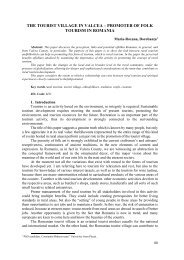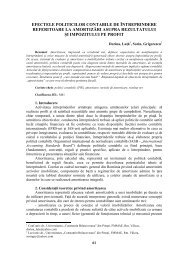equivalence versus non-equivalence in economic translation
equivalence versus non-equivalence in economic translation
equivalence versus non-equivalence in economic translation
You also want an ePaper? Increase the reach of your titles
YUMPU automatically turns print PDFs into web optimized ePapers that Google loves.
others (Snell-Hornby (1988) and Gentzler (1993) reject the theoretical notion of<strong>equivalence</strong>, claim<strong>in</strong>g it is either irrelevant or damag<strong>in</strong>g to TS. Neubert (1992: 142-146)th<strong>in</strong>ks that a complete theory of <strong>translation</strong> <strong>in</strong>cludes a theory of <strong>equivalence</strong> relationsconceived for both <strong>translation</strong> as a process and as a product. From our perspective, he isright when he stresses the need for such a theory postulat<strong>in</strong>g that <strong>translation</strong> <strong>equivalence</strong>must be considered a “semiotic category”, compris<strong>in</strong>g syntactic, semantic and pragmaticcomponents arranged <strong>in</strong> a hierarchical relationship. As soon as the translator moves awayfrom close l<strong>in</strong>guistic <strong>equivalence</strong>, the problems of determ<strong>in</strong><strong>in</strong>g the exact nature of the levelof <strong>equivalence</strong> aimed for beg<strong>in</strong> to emerge. From our po<strong>in</strong>t of view, Bassnett’s perspective(2002: 34) upon <strong>equivalence</strong> <strong>in</strong> <strong>translation</strong> holds valid <strong>in</strong> the sense that <strong>equivalence</strong> shouldnot be approached as a search for sameness, s<strong>in</strong>ce sameness cannot even exist between twoTL versions of the same text, let alone between the source language (SL) and the TLversion. Accord<strong>in</strong>gly, we are <strong>in</strong> favour of <strong>equivalence</strong> as “a dialectic between the signs andthe structures with<strong>in</strong> and surround<strong>in</strong>g the SL and the TL texts” (ibid.: 38).Even earlier, V<strong>in</strong>ay and Darbelnet (1995) have viewed <strong>equivalence</strong>-oriented<strong>translation</strong> as a procedure which “replicates the same situation as <strong>in</strong> the orig<strong>in</strong>al, whilstus<strong>in</strong>g completely different word<strong>in</strong>g” (342). They also suggest that, if this procedure isapplied dur<strong>in</strong>g the <strong>translation</strong> process, it can ma<strong>in</strong>ta<strong>in</strong> the stylistic impact of the SL text <strong>in</strong>the TL text. By contrast, Baker uses the notion of <strong>equivalence</strong> “for the sake of convenience– because most translators are used to it rather than because it has any theoretical status”(1992: 5-6). As a consequence, <strong>equivalence</strong> has been perceived <strong>in</strong> various ways be<strong>in</strong>gregarded as a necessary condition for <strong>translation</strong>, an obstacle to progress <strong>in</strong> TS or a usefulcategory for describ<strong>in</strong>g <strong>translation</strong>s. When she discusses those theoreticians who are <strong>in</strong>favour of <strong>translation</strong> as an <strong>equivalence</strong> theory, Kenny stipulates that “proponents of<strong>equivalence</strong>-based theories of <strong>translation</strong> usually def<strong>in</strong>e <strong>equivalence</strong> as the relationshipbetween a source text (ST) and a target text (TT) that allows the TT to be considered as a<strong>translation</strong> of the ST <strong>in</strong> the first place” (2001: 77). This def<strong>in</strong>ition of <strong>equivalence</strong> is rathergeneral and does not manage to cover the <strong>in</strong>tricacies of the term and the variety of aspectswhich <strong>equivalence</strong> encompasses. For <strong>in</strong>stance, Pym (1992: 37) has po<strong>in</strong>ted out thecircularity of <strong>equivalence</strong> which is supposed to def<strong>in</strong>e <strong>translation</strong> and <strong>translation</strong>, <strong>in</strong> turn, issupposed to def<strong>in</strong>e <strong>equivalence</strong>. Kenny (2001: 77) wishes more attempts were made todef<strong>in</strong>e <strong>equivalence</strong> <strong>in</strong> <strong>translation</strong> <strong>in</strong> a way that avoids this circularity.As far as we are concerned, the very fact that almost every <strong>translation</strong> theoreticianhas felt the need to express his/her op<strong>in</strong>ions either <strong>in</strong> favour of or aga<strong>in</strong>st the idea of<strong>equivalence</strong> <strong>in</strong> <strong>translation</strong> is a proof of its importance <strong>in</strong> TS. We consider thatterm<strong>in</strong>ological controversies should be carefully handled. All <strong>in</strong> all, we agree with Neubert(1992) that a theory of <strong>translation</strong> is undoubtedly based on a theory of <strong>equivalence</strong>relationships, but on the other hand we also th<strong>in</strong>k that Holmes (1988) is right when hebelieves that ask<strong>in</strong>g for sameness is ask<strong>in</strong>g too much.Understand<strong>in</strong>g the exact nature of <strong>equivalence</strong> rema<strong>in</strong>s a problematic issue.Accord<strong>in</strong>g to Nida, there are different types of <strong>translation</strong> due to the follow<strong>in</strong>g three basicfactors: (1) the nature of the message, (2) the purpose or purposes of the author and, byproxy, of the translator, and (3) the type of audience (cited <strong>in</strong> Venuti 2004: 127).In the case of <strong>economic</strong> <strong>translation</strong>, the decod<strong>in</strong>g ability and the potential <strong>in</strong>terest ofthe prospective audiences acquire great significance. Readers may be either the averageliterate adults who can handle both oral and written messages with relative ease or thespecialists <strong>in</strong> the field who have the necessary competence to decode messages with<strong>in</strong> theirarea of specialisation. Prospective audiences differ not only <strong>in</strong> decod<strong>in</strong>g ability, butperhaps even more <strong>in</strong> their <strong>in</strong>terests. Hence, a <strong>translation</strong> designed to stimulate read<strong>in</strong>g for75







